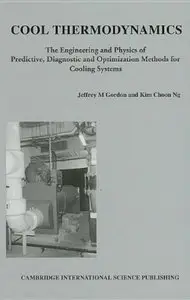Cool Thermodynamics: The Engineering and Physics of Predictive, Diagnostic and Optimization
by Jeffrey M Gordon, Kim Choon Ng
English | 2000 | ISBN: 1898326908 | 259 pages | PDF | 5.3 MB
by Jeffrey M Gordon, Kim Choon Ng
English | 2000 | ISBN: 1898326908 | 259 pages | PDF | 5.3 MB
This book is geared toward those interested in the engineering and physics of airconditioning and refrigeration devices (chillers). Analytic thermodynamic models are developed for a wide variety of cooling systems and a broad range of operating conditions. These models are easily implemented in the field or laboratory. Although the authors focus upon mechanical (electrically-driven) chillers - primarily reciprocating and centrifugal machines - there is also substantial material on heat-driven absorption chillers. Heat pumps and heat transformers are also addressed. A few less common chiller types are also treated, such as thermoelectric, thermoacoustic and vortex-tube units. The material is presented in a manner that can appeal to both the engineer and the physicist, and can form a bridge between the two communities in their analysis and presentation of cooling systems. In each chapter, the authors try to capture the basic physics of the problem, and to emerge with quantitatively accurate predictive and diagnostic tools. They aim for simple thermodynamic models where the functional dependences of chiller performance on the major operating variables are transparent. And all the models presented are required to stand the test of comparison against experimental performance data. The reader is shown how chillers can be viewed as input-output devices, viewed from the outside and probed with only externally-measurable parameters such as power input, cooling rate and coolant temperatures. measurable parameters such as power input, cooling rate and coolant temperatures. The type of information needed by chiller manufacturers and developers in designing and assembling new designs is alsoprovided. How will a given modification in a chiller component affect efficiency and cooling rate? What is the combination of operating conditions of the individual components that maximizes chiller efficiency at a required cooling rate? Many of the chapters can serve as an industry-oriented course tailored to cooling engineers. The book can also constitute part of a university course on cooling systems. Sections of the book can be included in introductory and advanced thermodynamics courses. Both engineering-oriented and physics-oriented topics are covered in most of the chapters. More than a dozen tutorial examples are included.
Please No mirrors.



